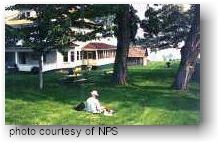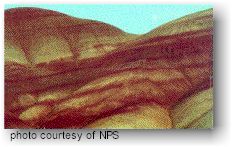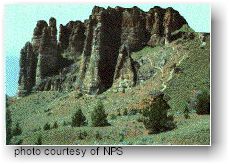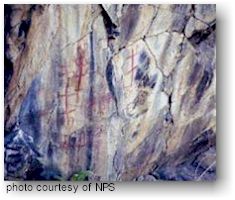| Description
Within the heavily eroded volcanic deposits of the
scenic John Day River basin is a well-preserved fossil record of plants
and animals. This remarkably complete record, spanning more than 40 of
the 65 million years of the Cenozoic Era (the "Age of Mammals and
Flowering Plants") is world-renown. Authorized October 26, 1974,
and established in 1975, this 14,000 acre park is divided into three
widely separated units; the Sheep Rock Unit, Painted Hills Unit, and
Clarno Unit.
|
|
Monument Information
Hours/Seasons: Park trails,
overlooks, and picnic areas open during daylight hours seven days a
week. The Thomas Condon Paleontology Center is open daily from 9:00 am to 5:00
pm year round. The James Cant Ranch House is open daily from 9:00 am to
5:00 pm during the summer, and from 10:00 am to 4:00 pm on weekdays
during winter months, weekends by appointment.
CLOSED: All Federal holidays from Thanksgiving through
Presidents Day.
|
|
History
John Day Fossil Beds National Monument is
named after the river and not the man. Still, how was the river named?
John Day was born in Culpeper County, Virginia, about 1770. In 1810 he
joined an overland expedition to establish a fur trading post at the mouth
of the Columbia River. The party became divided and widely separated.
Experiencing hardships, John Day's group dwindled to two people. He
and Ramsey Crooks eventually reached the mouth of the Mah-hah River along
the Columbia. There, a band of American Indians took everything they had,
including their clothes. They were rescued and reached Astoria (Oregon) in
1812. Due to this incident, people traveling along the Columbia
River would point out the mouth of the river where John Day was robbed. By
the 1850's, the Mah-hah River was referred to and renamed the John Day
River. If you name the mouth of a river, you name every stretch of
it upstream. It appears John Day never came within 100 miles of Sheep
Rock.
Thomas Condon
 Thomas
Condon (1822-1907) was a pioneer geologist, teacher, author, and clergyman
who came to Oregon around Cape Horn as a missionary in 1853. He
established a Congregational church at the Dalles in 1862 which embraced
all Christian faiths. Condon was the first scientific investigator of the
fossils in the John Day region, beginning with a visit to the area in1865
and followed by many more. In 1872, he became Oregon's first state
geologist while teaching geology at Pacific University. When the
University of Oregon was founded in 1876, Condon was appointed its first
professor of geology and continued as professor, and chair of Natural
Sciences until 1907. Condon's book, "The Two Islands" was the
foundation for the study of Oregon's historical geology. Thomas
Condon was originally born in Cork County, Ireland where he lived until
his family immigrated to New York. There, he had attended the Theological
Seminary at Auburn. Inspired by the Whitman expedition, Condon decided to
become a frontier missionary. In 1852, he and his wife Cornelia came to
the West Coast in a clipper ship, and settled in the Willamette Valley. By
1871, the Condons had eight children, and were living in the town of
Forest Grove. According to historic letters, one of Thomas Condon's
sons also later collected fossils near Sheep Rock, and sent correspondence
of his findings back to his father. Most of Thomas Condon's fossil
collections can be found at the University of Oregon and Pacific
University in Forest Grove, near Portland. By Congressional legislation,
the primary visitor center of John Day Fossil Beds National Monument will
be named in honor of Thomas Condon. Thomas
Condon (1822-1907) was a pioneer geologist, teacher, author, and clergyman
who came to Oregon around Cape Horn as a missionary in 1853. He
established a Congregational church at the Dalles in 1862 which embraced
all Christian faiths. Condon was the first scientific investigator of the
fossils in the John Day region, beginning with a visit to the area in1865
and followed by many more. In 1872, he became Oregon's first state
geologist while teaching geology at Pacific University. When the
University of Oregon was founded in 1876, Condon was appointed its first
professor of geology and continued as professor, and chair of Natural
Sciences until 1907. Condon's book, "The Two Islands" was the
foundation for the study of Oregon's historical geology. Thomas
Condon was originally born in Cork County, Ireland where he lived until
his family immigrated to New York. There, he had attended the Theological
Seminary at Auburn. Inspired by the Whitman expedition, Condon decided to
become a frontier missionary. In 1852, he and his wife Cornelia came to
the West Coast in a clipper ship, and settled in the Willamette Valley. By
1871, the Condons had eight children, and were living in the town of
Forest Grove. According to historic letters, one of Thomas Condon's
sons also later collected fossils near Sheep Rock, and sent correspondence
of his findings back to his father. Most of Thomas Condon's fossil
collections can be found at the University of Oregon and Pacific
University in Forest Grove, near Portland. By Congressional legislation,
the primary visitor center of John Day Fossil Beds National Monument will
be named in honor of Thomas Condon.
James Cant Ranch House
 The
Cant Ranch House, built in 1917, replaced a smaller dwelling located on
the present south lawn. The Cants, their four children, ranch hands, and
herders all lived in the house. Mrs. Cant frequently served dinner for
twenty or more. A room or meal was always available for a traveler.
Born in 1879, James Cant, Sr., left Scotland at the age of
20 for South America. There he spent five years raising horses to be used
in the Boer War. He then came to the United States and traveled overland
from New York to John Day country. Upon arrival in Dayville, in 1905,
James Cant herded sheep for the Murray family. After a few years he was
able to send for his sweetheart, Elizabeth, still in Scotland. They were
married in Canyon City on October 10, 1908. Two years later, Mr. Cant
purchased a ranch and 680 acres from the Officer family to begin his own
ranching operation. The furniture in the
parlor is on loan by the Cant family. Many of the furnishings were
gathered from other parts of the house. Photographs on the east wall
include James, Sr. [top center], James, Sr. and Elizabeth's wedding
picture [bottom center], and their children [left to right] Christina,
James, Jr., Charles, and Lillian. Lillian Cant
married Lawrence Mascall, and moved to the Mascall ranch located on the
south entrance to Picture Gorge. Earlier this century, the Mascall ranch
was a stopping place for many prominent fossil hunters. They included Dr.
John C. Merriam, a world-renown paleontologist, who named the Mascall
Formation after the ranch. The National Park
Service acquired a portion of the Cant Ranch in 1975 and plans to maintain
its historic appearance. To assure preservation, the ranch house,
surrounding buildings, and 200 acres were designated a National Historic
District. The
Cant Ranch House, built in 1917, replaced a smaller dwelling located on
the present south lawn. The Cants, their four children, ranch hands, and
herders all lived in the house. Mrs. Cant frequently served dinner for
twenty or more. A room or meal was always available for a traveler.
Born in 1879, James Cant, Sr., left Scotland at the age of
20 for South America. There he spent five years raising horses to be used
in the Boer War. He then came to the United States and traveled overland
from New York to John Day country. Upon arrival in Dayville, in 1905,
James Cant herded sheep for the Murray family. After a few years he was
able to send for his sweetheart, Elizabeth, still in Scotland. They were
married in Canyon City on October 10, 1908. Two years later, Mr. Cant
purchased a ranch and 680 acres from the Officer family to begin his own
ranching operation. The furniture in the
parlor is on loan by the Cant family. Many of the furnishings were
gathered from other parts of the house. Photographs on the east wall
include James, Sr. [top center], James, Sr. and Elizabeth's wedding
picture [bottom center], and their children [left to right] Christina,
James, Jr., Charles, and Lillian. Lillian Cant
married Lawrence Mascall, and moved to the Mascall ranch located on the
south entrance to Picture Gorge. Earlier this century, the Mascall ranch
was a stopping place for many prominent fossil hunters. They included Dr.
John C. Merriam, a world-renown paleontologist, who named the Mascall
Formation after the ranch. The National Park
Service acquired a portion of the Cant Ranch in 1975 and plans to maintain
its historic appearance. To assure preservation, the ranch house,
surrounding buildings, and 200 acres were designated a National Historic
District.
Sheep Rock
 Sheep
Rock, towering 1,100 feet over the John Day River, gives its name to this
unit. Wild big horn sheep and later a thriving sheep ranch both occupied
this landscape in the recent past. Meanwhile, the colorful layers of Sheep
Rock represent a more distant time, approximately 28 to 25 million years
ago. Then, the region was covered by deciduous forests, inhabited by
three-toed horses, rhinos, oreodonts, saber-toothed cat-like animals, and
lemur-like primates. Sheep
Rock, towering 1,100 feet over the John Day River, gives its name to this
unit. Wild big horn sheep and later a thriving sheep ranch both occupied
this landscape in the recent past. Meanwhile, the colorful layers of Sheep
Rock represent a more distant time, approximately 28 to 25 million years
ago. Then, the region was covered by deciduous forests, inhabited by
three-toed horses, rhinos, oreodonts, saber-toothed cat-like animals, and
lemur-like primates.
 The
Sheep Rock Unit is home to the James Cant ranch house (built 1918), now
the monument's visitor center. The visitor center features a fossil museum
and is the administrative headquarters for the monument. A series of
trails, outdoor exhibits, and overlooks are also available here. The
Sheep Rock Unit is home to the James Cant ranch house (built 1918), now
the monument's visitor center. The visitor center features a fossil museum
and is the administrative headquarters for the monument. A series of
trails, outdoor exhibits, and overlooks are also available here.
-
-
-
-
-
 The
Painted Hills Unit is 3,132 acres of scenic beauty unique in the Pacific
Northwest. Located 10 miles west of Mitchell, and 75 miles east of Bend,
it is visited year around. Over 32,000 people visited the unit last year,
with almost 10,000 of them hiking one or more of the unit's interpretive
trails. Outdoor exhibits and a picnic area are also available for visitors
here. The
Painted Hills Unit is 3,132 acres of scenic beauty unique in the Pacific
Northwest. Located 10 miles west of Mitchell, and 75 miles east of Bend,
it is visited year around. Over 32,000 people visited the unit last year,
with almost 10,000 of them hiking one or more of the unit's interpretive
trails. Outdoor exhibits and a picnic area are also available for visitors
here.
The yellows, gold, blacks, and
reds of the Painted Hills are best seen in the late afternoon. Even after
several visits, one may not see the same tone or hue as the claystones
differ with ever-changing light and moisture levels. The colors of the
hills are sublime. We like to think they even give the passing pronghorn
or mountain lion pause to reflect. Most years, the peak days of
wildflower season in late April to early May is spectacular.
Clarno Unit
 The
Clarno Unit is 1,969 acres in size and is located 18 miles west of the
town of Fossil. It has hiking trails, exhibits, and a picnic area, and
received over 12,000 visitors last year. The modern vegetation here is
typical of Central Oregon's near-desert environment with a variety of
grasses, sagebrush and juniper. The
Clarno Unit is 1,969 acres in size and is located 18 miles west of the
town of Fossil. It has hiking trails, exhibits, and a picnic area, and
received over 12,000 visitors last year. The modern vegetation here is
typical of Central Oregon's near-desert environment with a variety of
grasses, sagebrush and juniper.
- The cliffs of the Palisades are the most
prominent landform in the Clarno Unit. The Palisades were formed by a
series of volcanic mudflows in a much different environment 44 million
years ago. These mudflows, called lahars, preserved a great diversity
of fossils. At that time, the Clarno volcanoes dominated a landscape
covered by near-tropical forest, with approximately 100 inches of rain
per year. Tiny four-toed horses, huge rhino-like brontotheres,
crocodilians, and meat-eating creodonts roamed the ancient jungles.
Visitor Programs
- Plaza Talks ...
10am & 2pm daily on the plaza of the Thomas Condon Paleontology
Center. Join a park ranger for a 20-minute presentation introducing
the John Day Fossil Beds National Monument.
- Cant Ranch Walk ...
Beginning at 1:00 pm daily starting on the
porch,
these 45-minute tours feature an 20th century ranch life and eastern
Oregon cultural history.
- Evening with a Ranger
… 7pm on Saturdays at Clyde Holiday
State Park. Special talks on the mysteries revealed in John Day Fossil
Beds national Monument.
- Blue Basin Hikes …
10:30 am, Fridays-Sundays. Join a ranger for a 90-minute, guided hike into
the colorful Blue Basin. Tours begin at Blue Basin trailhead in the
Sheep Rock Unit.
- Dark Skies …
Call (541) 987-2333 for more details and times. Join a park ranger for
a two-hour exploration of the night sky over the Painted Hills.
Programs may include sky tour and observational session with
telescope, or a hike under the full moon. Meets at the Painted Hills
Overlook.
|





 The
Clarno Unit is 1,969 acres in size and is located 18 miles west of the
town of Fossil. It has hiking trails, exhibits, and a picnic area, and
received over 12,000 visitors last year. The modern vegetation here is
typical of Central Oregon's near-desert environment with a variety of
grasses, sagebrush and juniper.
The
Clarno Unit is 1,969 acres in size and is located 18 miles west of the
town of Fossil. It has hiking trails, exhibits, and a picnic area, and
received over 12,000 visitors last year. The modern vegetation here is
typical of Central Oregon's near-desert environment with a variety of
grasses, sagebrush and juniper.